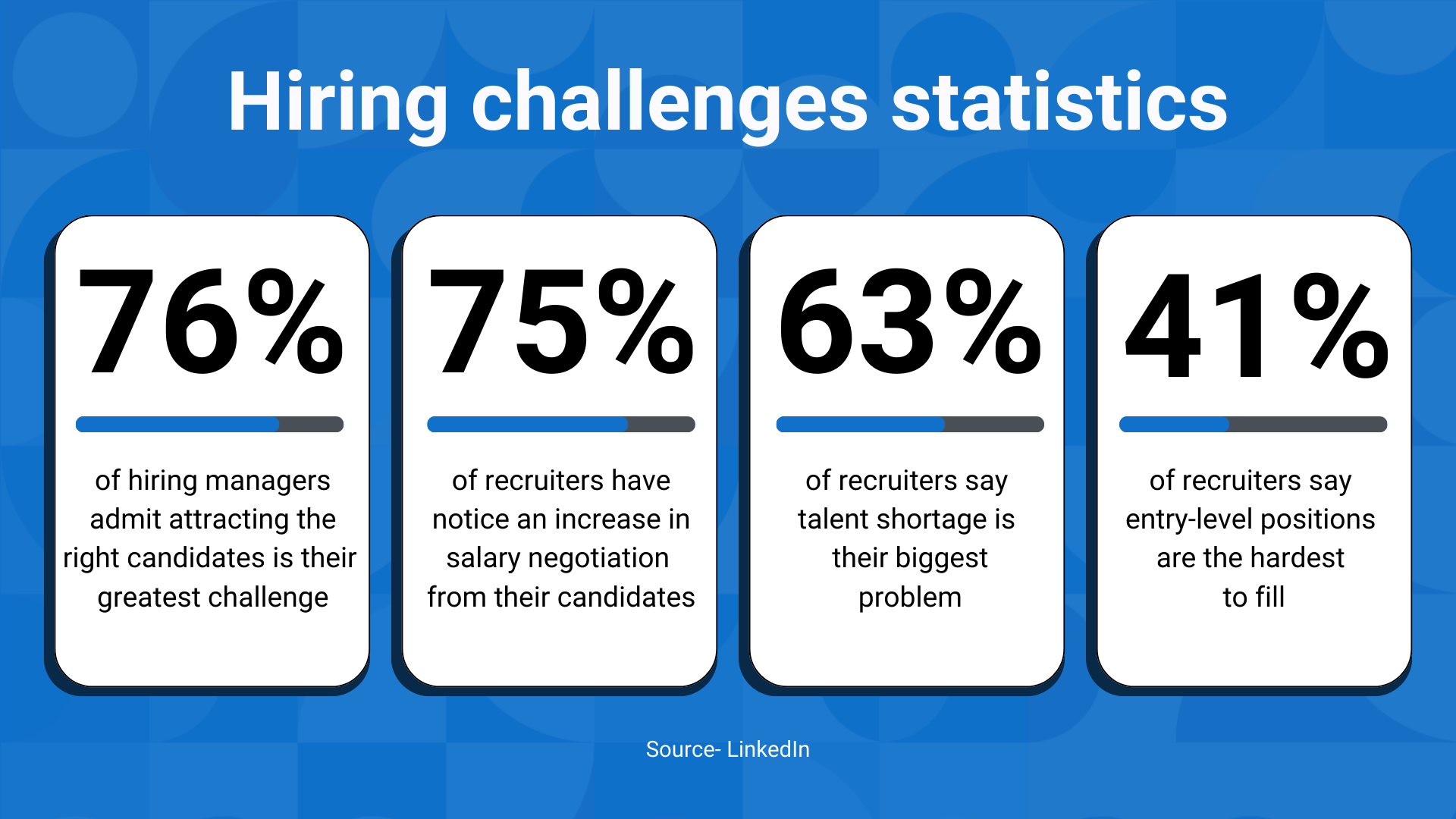 The latest Korn Ferry HR report made a startling prediction: More than 85 million jobscould go unfilled by 2030, resulting in about $8.5 trillion in unrealized annual revenue due to talent shortage.
The latest Korn Ferry HR report made a startling prediction: More than 85 million jobscould go unfilled by 2030, resulting in about $8.5 trillion in unrealized annual revenue due to talent shortage.
Amid this impending crisis, what do you think will be the #1 challenge most recruiters will face? – Finding the right talents at the right time
That’s where the need for proactive candidate sourcing strategies comes in!
The goals are simple:
- Build an active talent pipeline
- Attract top-tier talents
- Maximize the ROI of your sourcing efforts
And achieving these goals shouldn’t be difficult as well once you implement our 7 high-tech, high-touch candidate sourcing strategies.
These especially-curated tips will ensure a steady stream of qualified candidates, position your company as an employer of choice, and optimize your talent acquisition process like never before.
So, without further ado, let’s dive into the pointers!
Strategy 1: Know who and what to look for
Building a comprehensive candidate profile is the only right way to kickstart your candidate sourcing process. What must your candidate be like? What skills, qualifications, experiences, etc., must they possess? A profile includes answers to these (and many more relevant) questions.
Let’s see how you can build a perfect profile for your next hiring cycle!
Step 1: Determine the job responsibilities and qualifications
- Clearly define the specific job responsibilities, tasks, and required qualifications.
- Seek input from high-performing individuals within your company (or maybe network) to gather valuable insights and perspectives if it’s a new position.
Step 2: Conduct market research
- Explore the industry reports, salary surveys, and the local labor market, including the supply and demand for specific skills, to gain insights into candidate availability and competition.
- Identify unique qualities or characteristics that set your ideal candidates apart from others with similar backgrounds or experiences.
- This knowledge will help set realistic expectations and allows you to highlight differentiating factors during the sourcing phase.
Step 3: List out your must-haves and nice-to-haves
- Create a quick list of desired attributes for the ideal candidate, including both hard and soft skills.
- Differentiate between “must-have” qualifications and “nice-to-have” preferences to prioritize the most critical criteria.
- Assess how candidates will fit into the company culture and collaborate with the existing team to ensure a cohesive and productive work environment.
Step 4: Create candidate personas
- Utilize the gathered information to create a detailed ideal candidate profile.
- Include a thorough description of each attribute marked as ‘necessary’ for the position.
- Outline any expectations or stipulations that differentiate an ideal fit from other applicants who may not possess all the identified qualities but still have the potential to succeed.
Don’t know how to create a candidate persona? This template will help! 👇
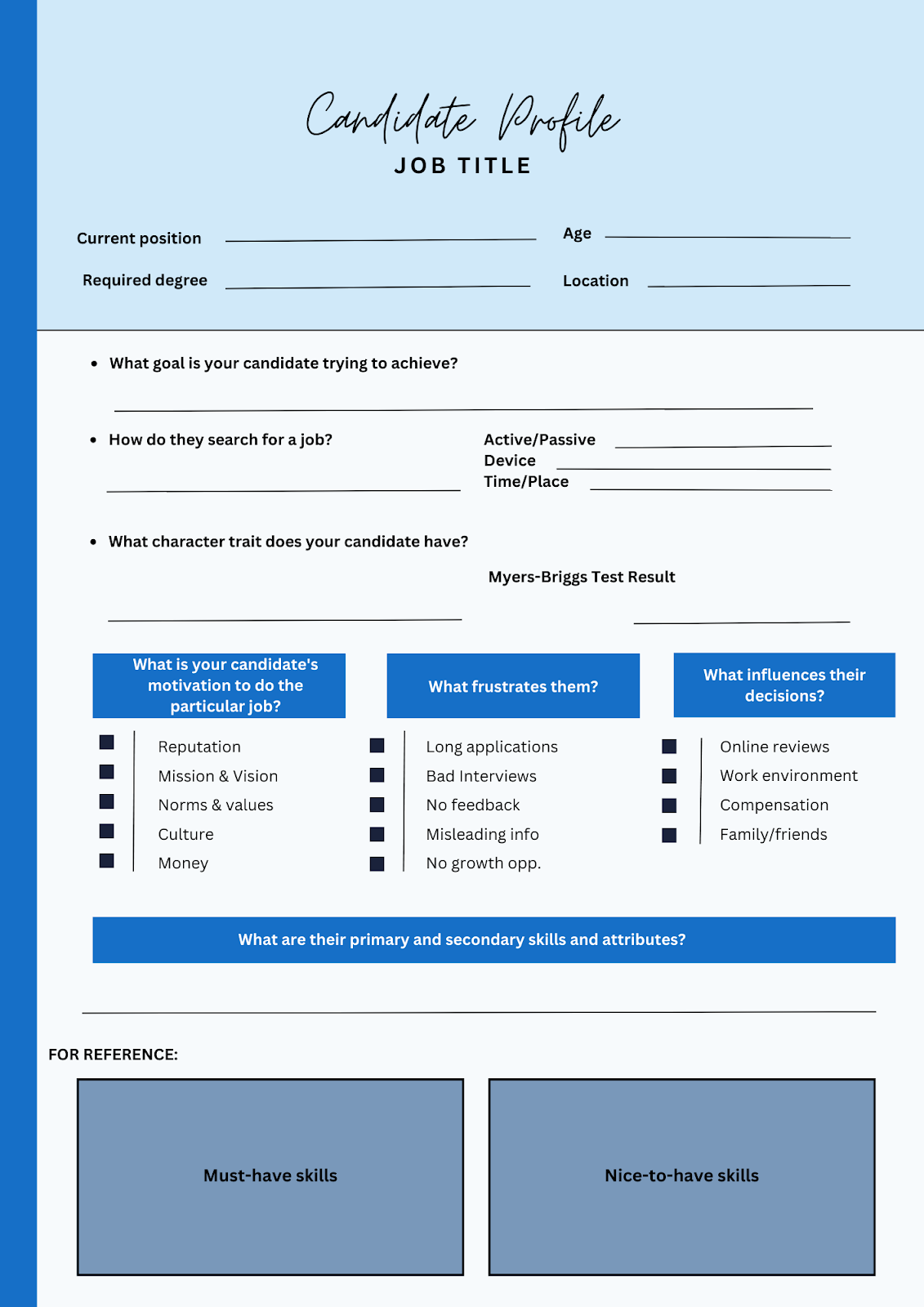
Step 5: Leverage innovative tools and techniques
- Utilize AI-powered talent analytics platforms to identify talent pools based on skills, experience, and potential.
- Explore social listening tools like Brand24, Mention, or Awario to monitor and analyze candidate sentiments and industry discussions.
- Consider using gamified assessment tools like Pymetrics or Traitify to evaluate candidates’ cognitive and behavioral traits in a unique and engaging way.
Step 6: Collaborate with internal stakeholders
- Work closely with hiring managers, department heads, and team members to understand each role’s desired skills and qualities.
- Encourage employee referrals and incentivize current employees to recommend qualified candidates.
Step 6: Monitor and adapt
- Continuously monitor industry trends, technology advancements, and changes in candidate preferences.
- Adjust your candidate personas and sourcing strategies to stay ahead of the curve.
Remember, staying agile and adapting to evolving market dynamics is essential to ensure continued success in candidate sourcing.
Strategy 2: Perfect your job descriptions
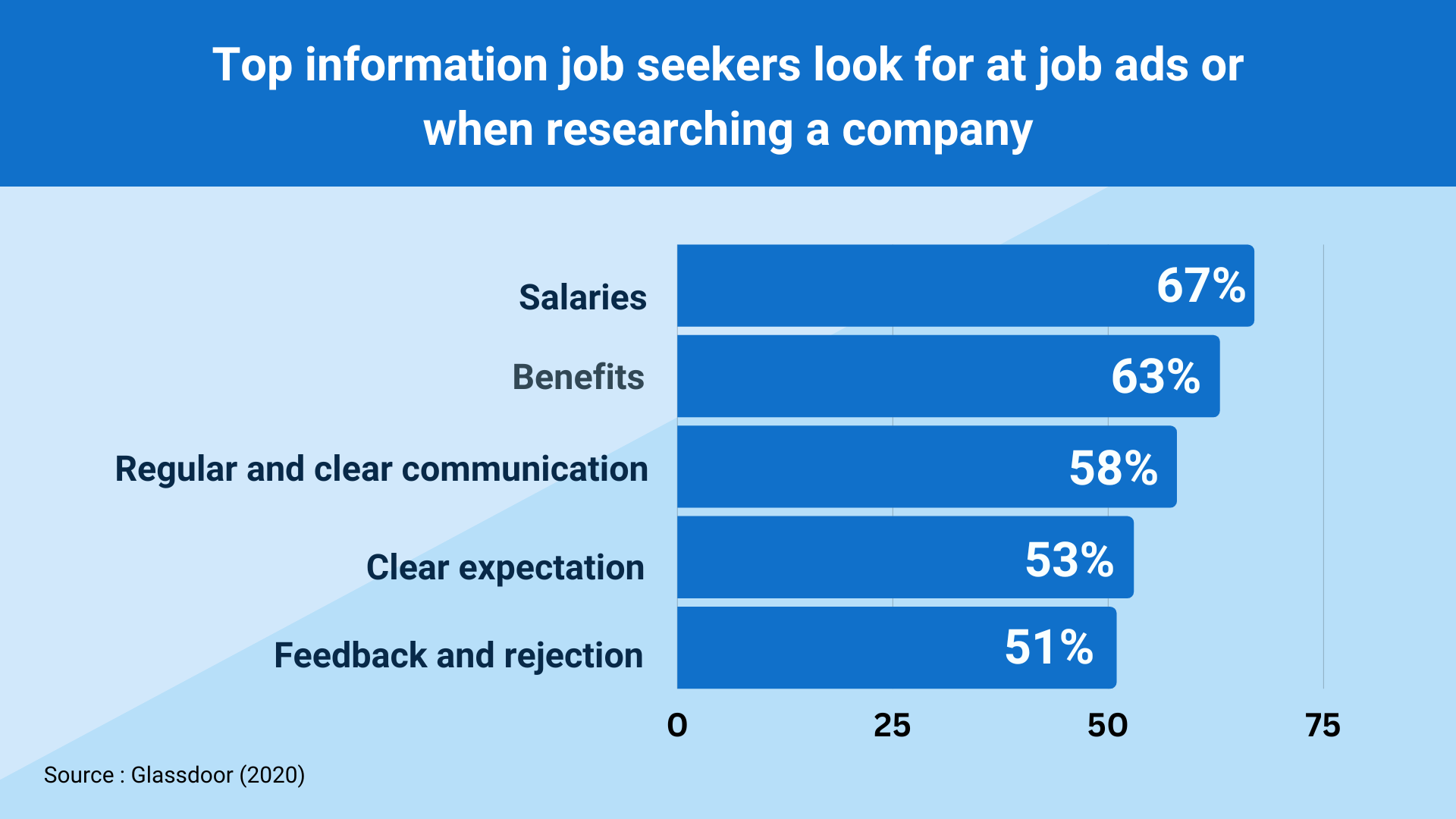
Yeah! Create a million-dollar job posting. Why? Here are a few reasons:
- It ensures clear communication about the role, responsibilities, and requirements, providing candidates with a comprehensive understanding of what is expected. This clarity helps candidates understand the role and reduce mismatches.
- Detailed descriptions help recruiters quickly filter candidates based on essential criteria.
- It showcases the company’s values and appeals to candidates aligned with its goals.
- It gives recruiters a competitive edge. By effectively highlighting the benefits and opportunities associated with the role, recruiters can differentiate their job postings from others, making them more appealing to potential candidates.
- Well-written job descriptions contribute to a positive candidate experience, fostering engagement and retention.
That said, now the main question is how can you perfect your job descriptions? Don’t worry, just avoid these mistakes–
- Vague language: Using ambiguous or unclear language can confuse candidates and lead to misunderstandings about the role and its requirements. Be specific and concise in your descriptions.
- Overwhelming jargon: Avoid using excessive industry-specific jargon that may alienate candidates unfamiliar with those terms. Ensure your job postings are easily understood by a broad audience.
- Lengthy descriptions: Lengthy job descriptions can be overwhelming and discourage candidates from applying. Keep your description concise and focus on crucial information.
- Unrealistic expectations: Setting unrealistic expectations for qualifications, skills, or experience may deter qualified candidates from applying. Ensure the requirements are practical and aligned with the position’s needs.
- Lack of information about the company: Neglecting to provide information about the company’s culture, values, and mission can make the job description appear impersonal. Include relevant details to attract candidates who align with your organization’s ethos.
- Missing key responsibilities: Failing to outline the primary responsibilities and duties of the role clearly can lead to misconceptions about the position. Ensure each candidate has a clear understanding of what the job entails.
- Ignoring diversity and inclusion: Neglecting to highlight the company’s commitment to diversity and inclusion may discourage candidates from underrepresented backgrounds. Showcase your inclusive values and create an environment that welcomes diverse talent.
- Neglecting perks and benefits: Forgetting perks, benefits, or growth opportunities can make the position less enticing. Highlight any unique traits or offers that set your company apart.
- Not proofreading for errors: Grammatical errors and typos can reflect poorly on your company’s professionalism and attention to detail. Thoroughly proofread the job description to ensure accuracy.
- Lack of mobile optimization: Neglecting to optimize your job description for mobile devices may limit accessibility for candidates. Ensure that the description is easy to read and navigate on mobile platforms.
By avoiding these mistakes, you can create job descriptions that attract and engage potential candidates, increasing your chances of quickly finding the right fit for your company.
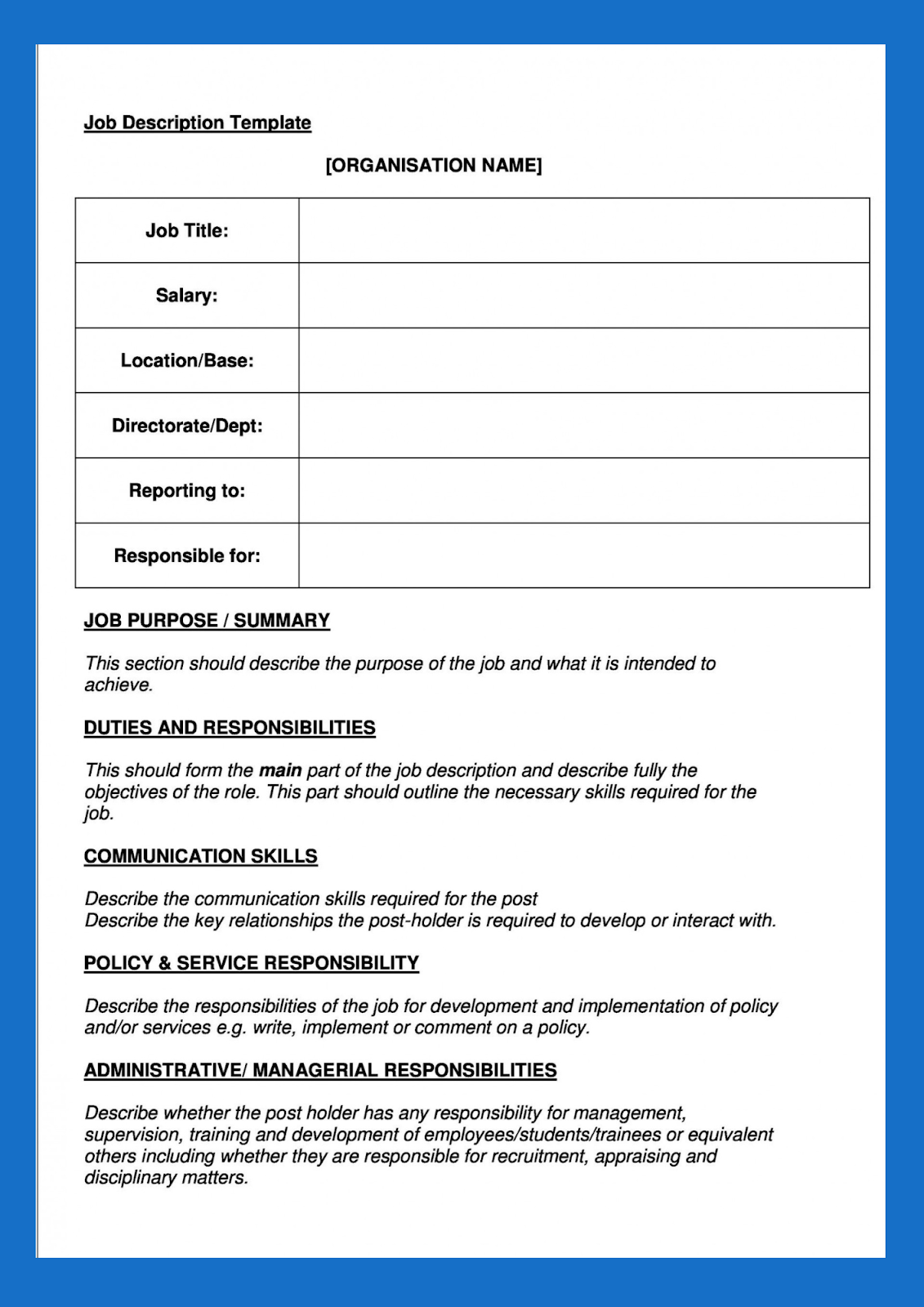
Want more?
Strategy 3: Get creative with your job posting approach
You know how to write a perfect job description, but it’s not enough. Your job post must stand out from the rest. Here are some creative approaches you can take to get started:
1. Micro-targeted job postings
Instead of generic job ads, create tailored job postings for specific audience segments.
Customize the language, format, and content of your job ads to resonate with different groups of candidates, such as recent graduates, mid-career professionals, or remote workers.
This approach increases the chances of attracting candidates who closely match your requirements.
Here are some tips for micro-targeting your job postings:
- Identify your target audience. Who are you looking for? What are their demographics? What are their interests?
- Choose the right channels. Where will your target audience be looking for jobs?
- Tailor your message. Speak to your target audience in a way that they will understand and appreciate.
- Track your results. Monitor your results to see what is working and what is not.
These tips can help you micro-target your job postings and maximize your ROI.
2. Interactive job postings
Make your job postings more engaging and interactive by incorporating multimedia elements like videos, infographics, or interactive quizzes.
It will help you capture candidates’ attention and make them more likely to read the entire description.
There are a few different ways to create interactive job postings. One way is to use a job board that allows you to add multimedia elements to your job ads.
Another way is to use a content management system (CMS) to add multimedia elements to your website.
Here are some tips for creating interactive job postings:
- Keep it concise: Avoid overwhelming your job postings with excessive multimedia content. Instead, focus on delivering essential information concisely and clearly. Use bullet points, subheadings, and short paragraphs to make it easy to read and digest.
- Make it visually appealing: While simplicity is important, incorporating visually appealing elements can enhance engagement. Use high-quality images or videos that showcase your company culture, work environment, or team. However, ensure the visuals are relevant and complement the content rather than overpowering it.
- Include interactive elements: Consider incorporating interactive elements such as quizzes, assessments, or challenges that allow candidates to showcase their skills or knowledge related to the role. This not only adds a fun element but also helps assess candidates’ suitability for the position.
- Highlight employee testimonials: Including testimonials from current employees can provide valuable insights into the work culture and environment. Encourage employees to share their experiences, successes, and growth opportunities within the organization. Authentic testimonials can help build trust and credibility with potential candidates.
- Optimize for mobile devices:
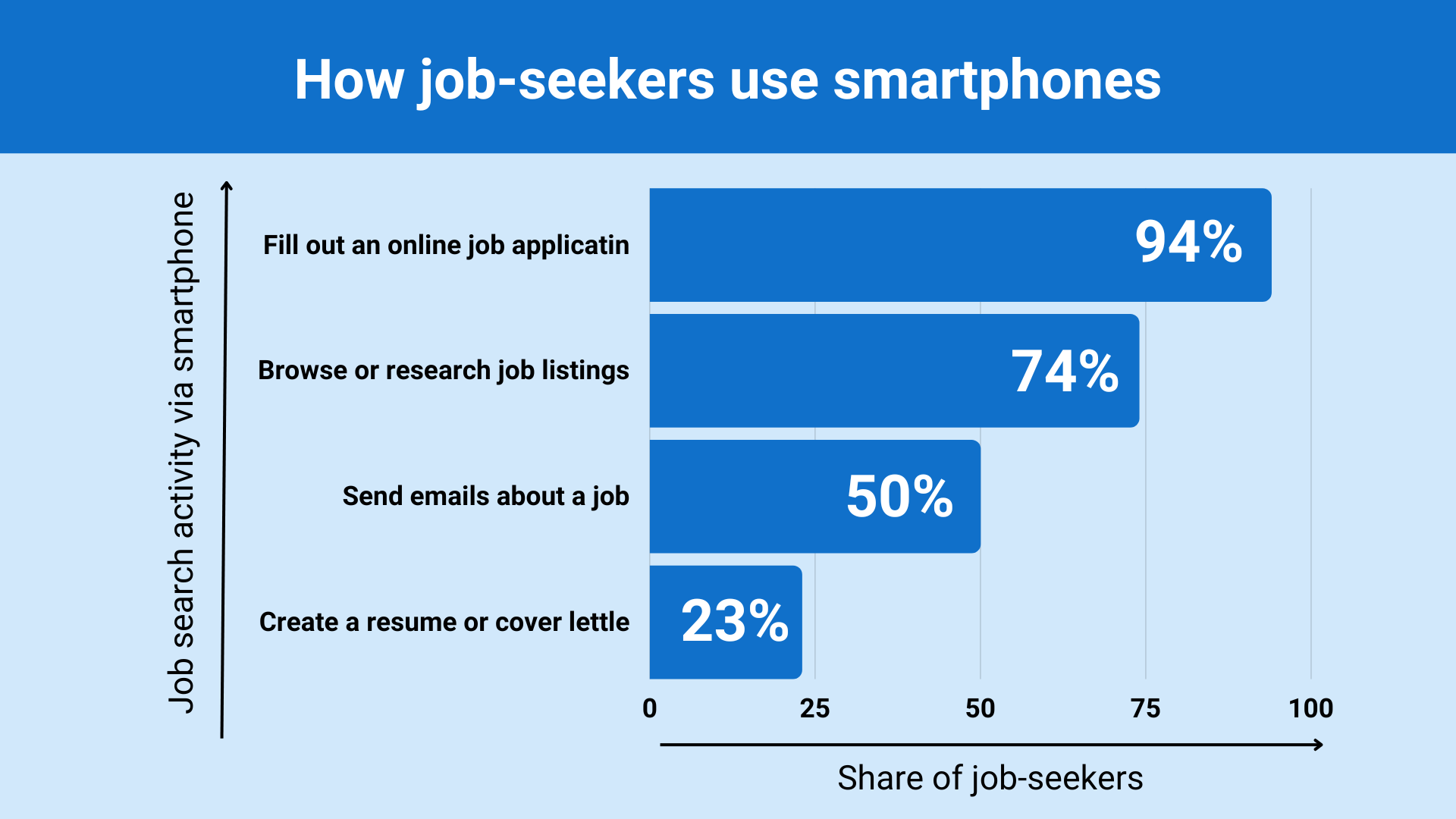
As more people use mobile devices for job searches, ensuring that your job postings are mobile-friendly is crucial. Optimize the layout, formatting, and content to ensure easy readability and navigation on various mobile devices. Use responsive design principles to adapt the posting to different screen sizes.
- Incorporate social sharing options: Make it easy for candidates to share your job postings on social media platforms. Include social sharing buttons or encourage candidates to share the opportunity with their networks. This can increase the visibility of your job postings and reach a broader audience.
- Use engaging language: Use a conversational tone and engaging language to make the job posting more captivating. Avoid excessive jargon and formalities that may discourage candidates. Speak directly to the candidates and highlight the benefits and opportunities associated with the position.
3. Job ad SEO-optimization
Optimize your job ads for search engines to improve their visibility and reach.
Conduct keyword research related to the job position and include those keywords naturally within the job description.
It increases the likelihood of your job postings appearing in relevant search results, attracting more qualified candidates.
Below are some hacks you can use to optimize your job postings for SEO:
- Include relevant keywords and phrases in your job titles and descriptions. When writing your job postings, consider the keywords that potential candidates will likely use when searching for jobs online. Include these keywords throughout your job postings. (Avoid keyword stuffing, though)
- Use descriptive titles. Your job titles are among the most important factors in determining whether or not potential candidates will see your job postings. Ensure your titles are descriptive and include relevant keywords.
- Write clear and concise descriptions. Your job descriptions should be clear and concise and provide potential candidates with all the information they need about the role. Include the job title, location, responsibilities, requirements, and benefits in your descriptions.
- Use images and videos. Images and videos not only make your job postings more visually appealing but also help improve your ranking, resulting in more exposure and shares.
- Use active voice and short sentences. Short and digestible sentences improve readability. And so does the active voice.
- Use keywords in your URL. The URL of your job posting is also an essential factor in determining its SEO ranking. You must include the focus keyword in your URL.
- Update your job postings regularly. The more frequently you update your job postings, the more likely potential candidates will see them.
4. Candidate-centric job descriptions
According to 86% of recruiters and 62% of employers, the current job market is entirely candidate-driven – SHRM
Instead of focusing solely on the requirements and responsibilities of the role, create job descriptions highlighting the value proposition for candidates.
Communicate the benefits, growth opportunities, and unique aspects of your company that make it an attractive place to work.
This approach helps to capture candidates’ interest and better showcase your employer brand.
To write effective candidate-centric job postings, consider the following tips:
- Highlight the role’s benefits: Focus on what candidates will enjoy about the role, including growth opportunities, perks, and benefits. Emphasize how the position can contribute to their professional development and success.
- Showcase company culture: Share the company’s mission, values, and work environment. Highlight opportunities for collaboration, teamwork, and any unique factor of the company culture that make it an appealing workplace.
- Simplify the application process: Make it easy for candidates to apply by streamlining the application process. A straightforward and user-friendly application system increases the likelihood of receiving more applications.
- Use positive language: Focus on positive aspects and opportunities rather than hostile or demanding language—frame requirements as opportunities for growth and development.
- Be specific: Provide clear and specific details about the role, responsibilities, and qualifications required. Avoid vague descriptions that may confuse candidates.
- Proofread carefully: Ensure your job postings are error-free by thoroughly proofreading them for typos and grammatical mistakes. Professional and polished job postings leave a positive impression on candidates.
5. Automated job distribution
Utilize job distribution tools or applicant tracking systems (ATS) that automatically distribute your job postings to multiple career sites and job boards simultaneously.
This will save your time and effort by streamlining the process of posting job ads on various platforms, reaching a broader candidate pool.
Some tools/platforms you can use to automate your job distribution process are:
- Applicant Tracking Systems (ATS): ATS platforms like RecruitCRM, Workday, and Lever often include job distribution capabilities. They allow recruiters to automate the posting of jobs to multiple job boards, career sites, and social media platforms.
- Job board distribution platforms: Tools like Broadbean, Jobvite, and JobDiva specialize in job distribution. They offer integrations with various job boards, allowing recruiters to post jobs to multiple platforms simultaneously.
- Social media management tools: With tools like Hootsuite, Buffer, and Sprout Social you can schedule your job posts on social media platforms in advance and track their performance.
- Programmatic job advertising platforms: Tools such as Joveo, Appcast, and PandoLogic use artificial intelligence and automation to optimize job ad distribution across various online channels, including job boards, search engines, and social media platforms.
- Career site content management systems: Platforms like Phenom, SmashFly, and Avature offer solutions for managing and automating the distribution of job content on your career site. They provide customizable templates, job listing management, and integration with job aggregators.
- Email marketing software: Tools like Mailchimp, Campaign Monitor, and Sendinblue can be utilized to automate job distribution through email campaigns. Recruiters can create targeted email lists and schedule automated job alerts to reach potential candidates.
- Recruitment marketing platforms: Solutions like Symphony Talent, SmashFly, and Phenom offer comprehensive recruitment marketing automation, including job distribution, candidate engagement, and analytics.
Strategy 4: Reach out on multiple channels
Fifty-two percent of recruiters have clarified that they first turn to their professional network to source their next hire.
Another twenty-eight percent say they first turn to LinkedIn.
Most recruiters have their channels decided they first turn to when recruiting. But only relying on a personal network or LinkedIn is not enough to find the best talent.
Various niche sites can be game changers for your candidate sourcing strategies, like:
| Niche platform | Specialization |
| GitHub Jobs | Software development and IT |
| Stack Overflow | Programming and tech-related roles |
| Dice | Technology and engineering |
| Behance | Creative and design roles |
| Dribbble | Design, illustration, and UI/UX |
| Health eCareers | Healthcare and medical professionals |
| NursingJobs.us | Nursing and healthcare |
| Mogul | Women |
| We work remotely | Remote workers |
Other than these, while social platforms like Quora, Slack, and Reddit are not specifically designed for recruitment purposes, they provide valuable opportunities to connect with individuals who share common interests.
By actively engaging in these communities, you can participate in conversations, identify passive candidates, and share your job ads.
Here are some specific strategies for leveraging these platforms effectively:
- Quora: Explore Quora’s vast knowledge base and search for individuals who provide detailed answers to job-related questions. These individuals often showcase their expertise and may demonstrate their potential as candidates for relevant roles within your organization.
- Slack: Join Slack communities that are relevant to specific fields or industries. These communities offer a less formal setting where you can interact with potential candidates and gain insights into their skills and interests. Participating in discussions allows you to build relationships and establish connections for future recruitment opportunities.
- Reddit: Use Reddit’s subreddit communities to post job ads and engage with potential candidates. Many subreddits have dedicated spaces for job listings and discussions related to specific industries or career paths. By actively participating in these communities, you can establish your presence, attract interested candidates, and have meaningful conversations about the available opportunities.
Back to job boards- Of course, platforms like LinkedIn are popular because it is the first choice of job seekers and employers. However, considering less frequently used channels can yield unique information about candidates that can be a source for personalized outreach.
Remember: The most crucial step to finding potential talent is to analyze your target audience and your expectations from them.
You must answer the following questions before sourcing candidates on online channels:
- Where should you start your search for someone professional in the domain? Should you reach freelancer sites or poach candidates working for your competitor companies?
- Where might a community related to a particular niche congregate?
- What companies are focused on similar services?
- What are the multiple job titles used by people in a particular domain?
Strategy 5: Source on social media
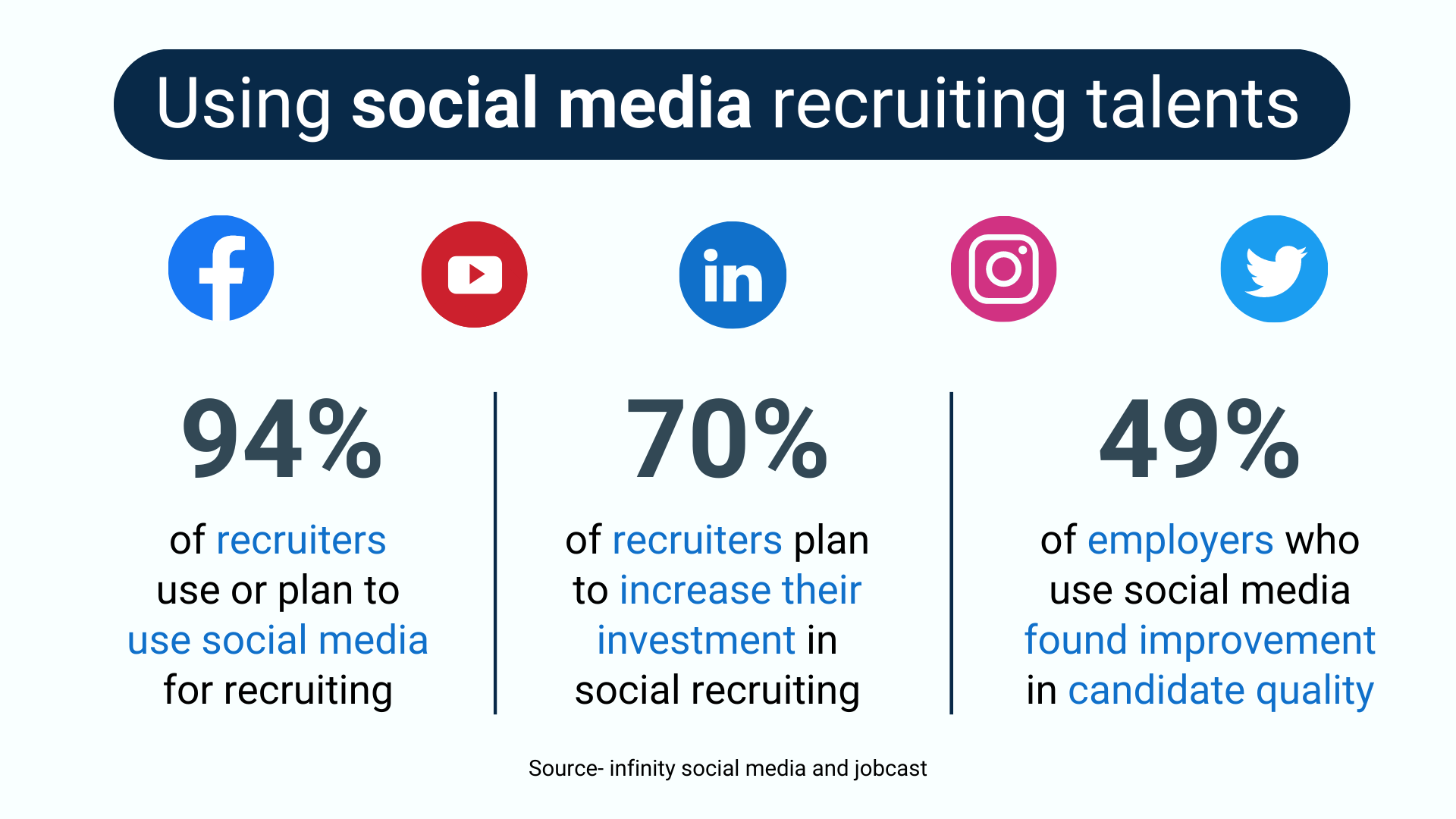
Social media (say Instagram, Facebook, Reddit, Ticktok, etc.) is one of the most popular talent identification channels.
It allows recruiters to verify the identity of candidates quickly and perform background checks on them. It also helps develop companies’ brands and networks.
Here are some tactics to enhance your social media sourcing strategy:
a. Leverage hashtags
Hashtags are widely used on social media platforms like Twitter, LinkedIn, and Instagram. They allow you to categorize and search for content related to specific topics or interests.
Identify relevant industry or job-specific hashtags and use them in your social media posts and searches. It will help discover candidates actively discussing or sharing content about your target job roles.
b. Engage with professional groups and communities
Join industry-specific groups and communities on platforms like LinkedIn and Facebook. These groups often offer active discussions, job postings, and opportunities to connect with professionals in your field.
Engage in conversations, share relevant content, and build relationships with potential candidates to establish yourself as a trusted recruiter and attract qualified individuals to your opportunities.
c. Follow and connect with thought leaders
Identify influential leaders, industry experts, and professionals in your target talent pool. Follow them on social media platforms and engage with their content.
This will keep you informed about industry trends, gain insights, and connect with candidates who follow these thought leaders.
d. Share compelling job postings and content
Create attractive and engaging job postings to share on your social media profiles. Use visually appealing images or videos and craft compelling captions that highlight the key aspects of the role.
Additionally, share relevant industry news, career advice, and content that resonates with your target audience. It will position you as a valuable resource and increase the likelihood of attracting passive candidates.
e. Utilize advanced search features
Some social media platforms offer advanced search features to filter results based on criteria such as location, job title, education, and experience. Explore these features to narrow your search and find candidates who meet your requirements.
f. Engage with potential candidates
Once you identify potential candidates on social media, engage with them through comments, direct messages, or by sharing their content. Personalized interactions can build rapport and increase their likelihood of considering your job opportunities.
By incorporating these tactics into your candidate sourcing strategies, you can effectively identify, engage, and attract qualified candidates from social media platforms.
Remember to maintain a professional and authentic approach while interacting with potential candidates and stay updated with the latest trends in social media recruitment strategies.
g. Use Boolean search
Like any search engine, boolean search works great for social media platforms as well. It allows you to combine keywords and operators to create more targeted and precise searches.
You can refine your search queries by utilizing boolean search operators and narrowing down the results to find candidates who meet specific criteria.
Here are some commonly used boolean search operators and tips on how they can be applied in social media sourcing:
- AND: Use the “AND” operator to combine multiple keywords and ensure both terms appear in the search results. For example, searching for “software engineer AND Python” will yield results that include both keywords, helping you find candidates with experience in Python programming.
- OR: The “OR” operator expands your search to include either of the specified terms. It’s useful when multiple variations or synonyms exist for a skill or job title. For instance, searching for “project manager OR program manager” will retrieve results that include either term, broadening your candidate pool.
- NOT: The “NOT” operator allows you to exclude specific terms from your search results. It can help filter out irrelevant information. For example, searching for “marketing manager, NOT intern” will exclude any results that mention the term “intern.”
- Quotation marks: By enclosing a phrase within quotation marks, you can search for an exact match of that phrase. This is useful when looking for candidates with specific job titles or skills. For instance, searching for “full-stack developer” will retrieve results that contain the exact phrase “full-stack developer.”
- Parentheses: Parentheses help to group search terms and operators, enabling you to create complex search queries. It is useful when combining different operators or searching for specific keyword combinations. For example, searching for “(Java OR Python) AND (backend OR server-side)” will retrieve results that include either Java or Python, as well as backend or server-side terms.
Strategy 6: Make the most out of your employees network
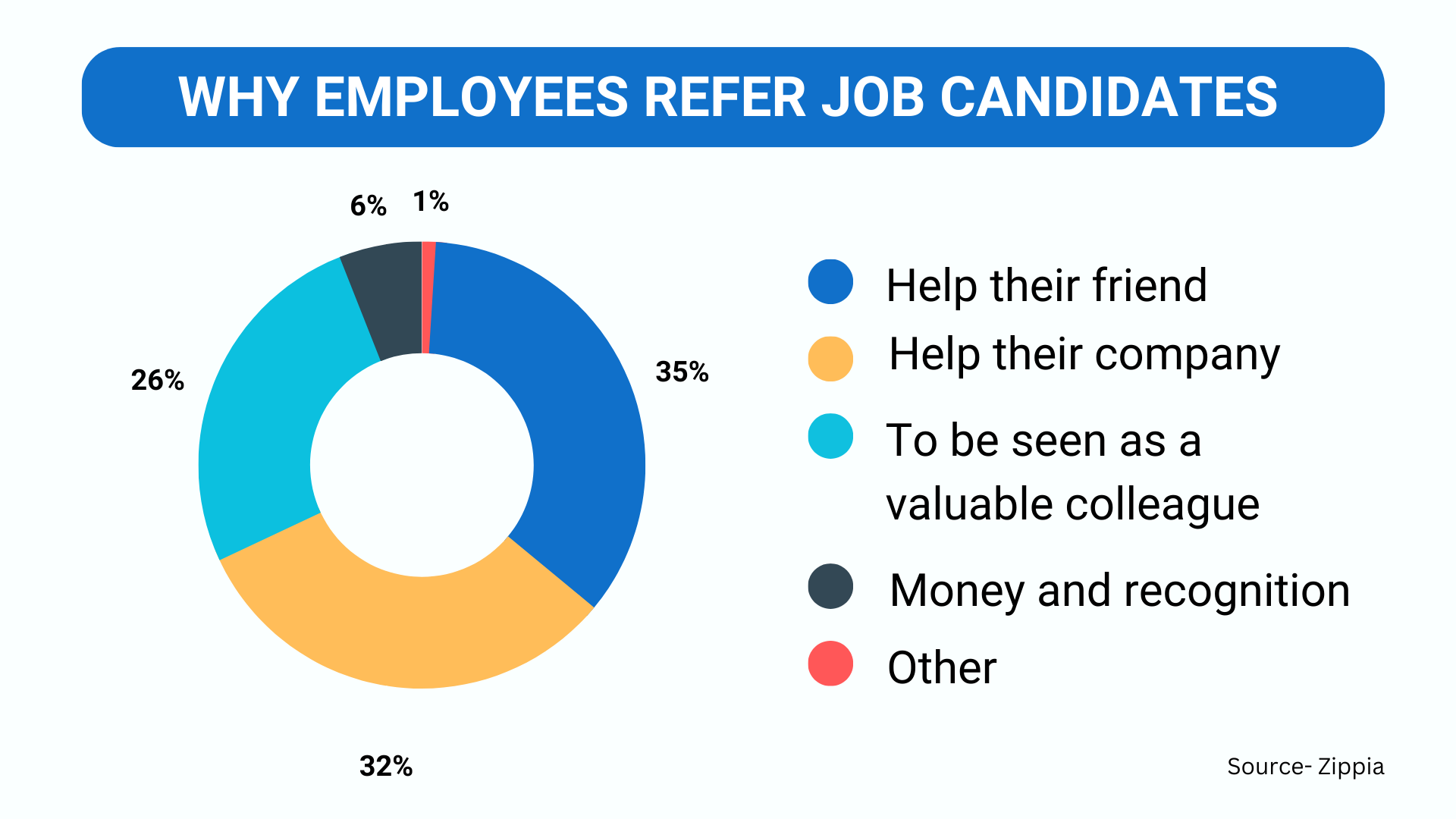
Your employees can be more beneficial for you when sourcing candidates than you can ever imagine. Wanna know how? Read the following:
1. Referral programs
Implement a robust employee referral program that incentivizes and rewards employees for referring qualified candidates.
Offer incentives such as monetary bonuses, recognition, or extra vacation days to encourage employees to refer candidates from their networks actively.
Promote the program through internal communication channels and create a streamlined process for submitting referrals.
2. Employee testimonials and ambassadorship
Encourage your employees to share positive experiences and testimonials about their work and the company on their social media or personal blogs.
It will showcase their enthusiasm for the organization and can attract passive candidates who trust the opinions of current employees.
Consider establishing an employee ambassador program where selected employees actively promote the company’s culture, values, and job opportunities on social media.
3. Networking events and industry conferences
Provide opportunities for your employees to attend networking and industry conferences. Encourage them to converse, exchange contact information, and build relationships with potential candidates.
These events can be a fruitful way to expand your talent network and tap into passive candidates who may not be actively job-hunting.
4. Internal talent marketplace
Create an internal talent marketplace where employees can showcase their skills, expertise, and career aspirations.
This platform will allow employees to express interest in different projects or roles within the company and allows managers and recruiters to identify internal talent for open positions. It will promote internal mobility and reduce the need for external sourcing.
5. Employee-led initiatives
Encourage employees to participate in industry-specific associations, forums, or online communities.
This involvement will position them as knowledgeable and respected professionals and expand their network.
They can leverage these connections to identify potential candidates who align with your organization’s values and requirements.
6. Alum networks
Tap into the network of former employees who have left the organization on good terms.
Maintain relationships with alums and keep them informed about new job opportunities.
These alums can be your brand ambassadors and refer potential candidates from their workplaces or professional networks.

Must-do:
- Encourage employee participation, provide necessary resources and incentives, and create a culture of networking and collaboration within your company.
- Train employees on social media best practices and guidelines for professional networking. Teach them how to optimize their profiles, engage with industry-specific groups and communities, and effectively share job openings and company updates.
- Appreciate them always!
Strategy 7: Partner with universities
Establishing partnerships with universities and colleges presents an excellent opportunity to tap into a fresh and motivated talent pool.
You can access a diverse range of competent candidates by actively participating in campus recruitment events and job fairs and offering internships or apprenticeships.
Research conducted in 2021 revealed that 72% of employers experienced successful hiring through college recruiting efforts.
To make the most of this avenue, engage with university career centers and academic departments to foster strong relationships that can result in a steady flow of qualified candidates.
Beyond recruitment benefits, collaborating with educational institutions can also provide valuable insights into your industry’s latest research and innovations.
By sponsoring research projects or offering guest lectures, you contribute to the academic community and solidify your connection to it.
These partnerships offer a mutually beneficial arrangement: you gain access to promising talent while universities benefit from industry expertise and support.
Building long-term relationships with educational institutions positions your organization as an attractive employer and establishes a reputation for innovation and collaboration within your industry.
Were these tips helpful? Do you have more in mind? Let us know in the comments.
Thank you for following through~
Frequently asked questions (FAQs)
Q1- What is candidate sourcing?
Candidate sourcing is the process of proactively identifying and attracting potential candidates to fill job vacancies within a company.
It involves searching various online and offline channels to find individuals with the desired skills, qualifications, and experience.
Some of the best sourcing practices include searching resume databases, utilizing social media platforms, attending networking events, and leveraging employee referrals to identify qualified candidates.
Q2- What is the primary goal of candidate sourcing?
The primary goal of candidate sourcing is to build an evergreen pipeline of qualified candidates for current and future job openings.
It aims to proactively identify and engage with potential candidates who may be a crucial company asset, despite not actively seeking employment.
By building a talent pool, companies can reduce time-to-hire, ensure a higher quality of candidates, and increase the likelihood of finding the best fit for their roles.
Q3- How is candidate experience related to candidate sourcing?
Candidate experience refers to an applicant’s overall journey and perception throughout the hiring process. It plays a crucial role in candidate sourcing, directly impacting an employer’s ability to attract and retain top talent.
A positive candidate experience during the sourcing stage can help build a favorable employer brand, encourage candidates to engage further, and increase the chances of successful hires.
Clear communication, timely feedback, and a seamless application process are vital to ensuring a positive candidate experience.
Q4- How does an employer brand affect candidate sourcing strategies?
Employer brand, representing an organization’s reputation and value proposition as an employer, significantly impacts candidate sourcing strategies.
A strong employer brand helps attract top talent, as candidates are more likely to be drawn to companies known for their positive work culture, career development opportunities, and employee satisfaction.
A well-established employer brand can make sourcing efforts more effective by increasing candidate interest and improving the quality of applicants.
Q5- How are sourcing and recruiting different?
Sourcing and recruiting are related but distinct processes within the hiring cycle. Here is a quick differentiation table for you:
| Sourcing | Recruiting | |
| Definition | The proactive process of identifying and attracting potential candidates for job openings. | The overall process of attracting, evaluating, and selecting candidates for specific job positions. |
| Focus | Identifying and engaging potential candidates to build a talent pool. | Evaluating and selecting candidates from the talent pool for specific job positions. |
| Timing | Precedes the recruiting process and often happens before specific job openings arise. | Follows sourcing and involves the entire hiring process, including screening, interviewing, and making job offers. |
| Objective | Building a pipeline of qualified candidates for current and future job openings. | Filling specific job positions with the most suitable candidates from the talent pool. |
| Activities | Searching and researching potential candidates, networking, and building relationships. | Screening resumes, conducting interviews, assessing skills and qualifications, and making hiring decisions. |
| Key Skills | Strong research, sourcing techniques, and networking abilities. | Screening, interviewing, and evaluation skills, as well as a thorough understanding of job requirements. |
| Scope | Broader in scope, targeting potential candidates beyond immediate hiring needs. | Focused on filling specific job positions based on identified requirements. |
| Timeframe | The ongoing and continuous process of maintaining a talent pipeline. | Time-limited and typically associated with filling a specific job opening. |
Q6- What metrics should I track to ensure the effectiveness of my candidate sourcing strategies?
Tracking and analyzing relevant metrics can help evaluate the effectiveness of candidate sourcing strategies. Key metrics to consider include:
- Sourcing channel performance: Keep your eye on the performance of each sourcing platform to determine which channels yield the highest-quality candidates.
- Time-to-fill: Track the time it takes to fill positions from the initial sourcing stage to the final offer acceptance.
- Conversion rates: Monitor the percentage of sourced candidates who progress through the different stages of the hiring process.
- Quality of hire: Assess the performance and retention of candidates sourced compared to other channels.
- Cost-per-hire: Calculate the expenses associated with candidate sourcing efforts, including sourcing tools, advertising, and recruitment agency fees.
Q7- What is the best candidate sourcing software I can use for my staffing firm?
The choice of candidate sourcing software depends on multiple factors, like the size of your staffing firm, specific needs, and budget. Some popular candidate-sourcing software options include:
- Recruit CRM
- LinkedIn Talent Solutions
- Indeed Resume
- CareerBuilder Talent Discovery
- Entelo, etc.
Consider evaluating the features, user reviews, and pricing options of different software solutions to find the one that aligns with your firm’s requirements.
Q8- How can I choose the ideal sourcing tools for my business?
To choose the ideal sourcing tools for your business, consider the following factors:
- Alignment with your sourcing strategy and goals
- User-friendliness and ease of integration
- Compatibility with your existing technology stack
- Availability of relevant candidate data and search capabilities
- Pricing and scalability of the tool
- Support and customer service provided by the vendor
- Recommendations and feedback from other users or industry professionals
Conduct thorough research, read reviews, and request demos or trials to assess the suitability of the sourcing tools for your specific business needs.
Q9- What are the key benefits of effective candidate sourcing?
Effective candidate sourcing offers several benefits, including:
- Access to a wider pool of qualified candidates
- Reduction in time-to-hire by proactively engaging with potential candidates
- Improved quality of hires through targeted sourcing efforts
- Increased diversity and inclusion by actively seeking candidates from underrepresented groups
- Cost savings compared to traditional reactive recruitment methods
- Enhanced employer brand through positive candidate experiences and reputation in the market
Q10- What are some common mistakes to avoid during candidate sourcing?
Some common mistakes you must avoid during candidate sourcing include:
- Overlooking passive candidates who may be open to new opportunities
- Neglecting to build and maintain relationships with potential candidates
- Relying solely on one sourcing channel instead of utilizing multiple channels
- Failing to personalize outreach and communicate the value proposition effectively
- Disregarding the candidate’s experience and providing poor communication or delayed feedback
- Not tracking and analyzing sourcing metrics to evaluate and optimize strategies
- Ignoring the importance of employer branding in attracting and engaging candidates
Q11- How can I effectively engage with candidates during the sourcing process?
To effectively engage with candidates during the sourcing process:
- Personalize your outreach to demonstrate a genuine interest in their skills and experiences.
- Clearly communicate the value proposition and benefits of working for your company.
- Provide timely and transparent communication throughout the process, including regular updates and feedback.
- Actively listen to candidates’ needs and concerns, addressing them appropriately.
- Offer opportunities for candidates to showcase their abilities or engage in meaningful conversations, such as through informational interviews or networking events.
- Foster a positive candidate experience by ensuring a seamless and user-friendly application process.
Q12- What are the legal considerations and compliance requirements in candidate sourcing?
Legal considerations in candidate sourcing include adhering to anti-discrimination laws, data protection regulations, and privacy laws.
Ensure that your sourcing practices comply with equal employment opportunity (EEO) laws and do not discriminate based on specific characteristics.
Also, handle candidate data in compliance with applicable data protection and privacy laws, obtaining necessary consent and implementing appropriate security measures.
Q13- How can I maintain a diverse candidate pool through sourcing?
To maintain a diverse candidate pool through sourcing:
- Use a variety of sourcing channels to reach candidates from different backgrounds.
- Employ inclusive language and imagery in job descriptions and sourcing materials.
- Actively engage with diversity-focused businesses, networks, or communities.
- Encourage employee referrals and implement diversity-focused referral programs.
- Conduct blind resume screening to reduce unconscious bias during the initial selection process.
- Regularly review and evaluate your sourcing strategies to ensure they are inclusive and effective in attracting diverse candidates.
Q14- What are the emerging trends and innovations in candidate sourcing?
Emerging trends and innovations in candidate sourcing include:
- AI-powered sourcing tools that automate candidate screening and matching.
- Integration of chatbots and virtual assistants for initial candidate interactions.
- Social media and online platforms are becoming prominent sourcing channels.
- The rise of employer branding and employer value proposition in attracting candidates.
- Increased focus on data-driven sourcing strategies, leveraging analytics and predictive modeling.
- Utilization of gamification and interactive assessments to evaluate candidate skills and fit.
Stay updated with industry news, attend conferences, and explore HR and talent acquisition publications to stay informed about the latest research and trends in candidate sourcing.




